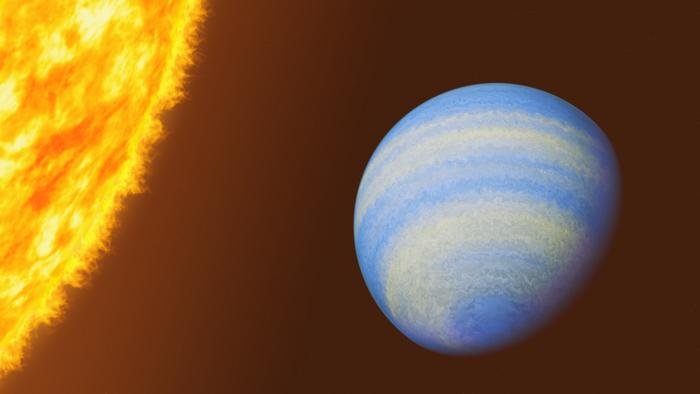A multi-university team of researchers led by Johns Hopkins University recently identified a crucial compound in the atmosphere of exoplanet HD 189733 b: hydrogen sulfide, a chemical that smells of rotten eggs.
Their findings, published recently in Nature, analyzed data taken from the James Webb Space Telescope (JWST), revealing that sulfur could play a key role in developing exoplanets.
“Hydrogen sulfide is a major molecule that we didn’t know was there. We predicted it would be, and we know it’s in Jupiter, but we hadn’t really detected it outside the solar system,” explained Johns Hopkins astrophysicist and researcher Guangwei Fu in a recent press release. “We’re not looking for life on this planet because it’s way too hot, but finding hydrogen sulfide is a stepping stone for finding this molecule on other planets and gaining more understanding of how different types of planets form.”
A Benchmark Planet
Nestled at only 64 light-years from Earth, exoplanet HD 189733 b is a good benchmark for astrophysicists to understand the atmospheres of exoplanets better. Since its discovery in 2005, HD 189733 b is also the closest exoplanet that scientists have seen passing in front of its star, as it is 13 times closer to its own star than Mercury is to the Sun and takes a mere two Earth days to complete a full orbit. It’s also been considered a “hot Jupiter” as it’s similar in mass to the infamous gas giant and has 1.13 times Jupiter’s radius.
However, HD 189733 b is far from hospitable, with 5,000 mph winds and temperatures of 1,700 degrees Fahrenheit. Scientists have also observed severe weather raging through its atmosphere, which piqued their interest in the molecules within the exoplanet’s atmosphere.
Sulfur’s Importance For Exoplanet Formation
By detecting sulfur in the form of hydrogen sulfide in the exoplanet’s atmosphere, Fu and the other researchers were excited by the bigger implications of this find.
“Sulfur is a vital element for building more complex molecules, and—like carbon, nitrogen, oxygen, and phosphate—scientists need to study it more to fully understand how planets are made and what they’re made of,” Fu added in the press release. “Say we study another 100 hot Jupiters and they’re all sulfur enhanced. What does that mean about how they were born and how they form differently compared to our own Jupiter?”
Other Space Chemistry
Using the infrared wavelengths from the JWST data, the researchers also measured the planet’s atmospheric carbon and oxygen levels with new precision. While previous research suggested that HD 189733 b also had methane in its atmosphere, the researchers could not validate this claim.
“We had been thinking this planet was too hot to have high concentrations of methane, and now we know that it doesn’t,” Fu said.
Further analyzing the JWST data, the researchers measured the amounts of heavy metals within HD 189733 b’s atmosphere. Scientists can see if these two things are connected by looking at the levels of heavy metals compared to the planet’s mass. The smaller, colder planets like Uranus and Neptune contain more significant concentrations of heavy metals than gas giants like Jupiter, suggesting that the higher metal concentrations help these planets accumulate more rocks and ice, making the planets denser.
However, scientists are still testing whether this relationship is the same for exoplanet formation.
“This Jupiter-mass planet is very close to Earth and has been very well studied. Now we have this new measurement to show that indeed the metal concentrations it has provide a very important anchor point to this study of how a planet’s composition varies with its mass and radius,” Fu said in the press release. “The findings support our understanding of how planets form through creating more solid material after initial core formation and then are naturally enhanced with heavy metals.”
With higher resolution from advanced instruments like the James Webb Space Telescope, scientists can study more exoplanets to try and determine this possible connection.
Fu and the rest of the researchers plan to use more JWST data to study other exoplanets in hopes of finding sulfur in their atmospheres as well. This could help further determine the connection sulfur has to exoplanet formation, specifically if it influences how close exoplanets are to their parent stars.
“We want to know how these kinds of planets got there, and understanding their atmospheric composition will help us answer that question,” Fu said.
Kenna Hughes-Castleberry is the Science Communicator at JILA (a world-leading physics research institute) and a science writer at The Debrief. Follow and connect with her on X or contact her via email at kenna@thedebrief.org

